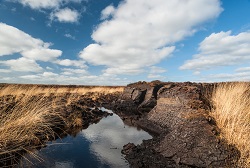How climate change affects peatland carbon stores
Peat occurs in wetlands and comprises dead material from plants and mosses, which do not fully decompose due to the absence of oxygen. Peatlands are mainly found in temperate regions, but significant deposits also exist in the tropics and the Arctic. Any changes in the microbial metabolism of carbon in peatlands could significantly affect the amount of carbon dioxide (CO2) released into the atmosphere and dissolved organic carbon (DOC) levels in water bodies. The EU-funded Horizon 2020 MicroPEAT project assessed peatlands and their associated microbial communities to understand their ecology and how they will be affected by climate change. “This study will improve our understanding of peatlands from a global perspective, focusing on the link between microbes and ecosystem functioning,” says project coordinator Prof. Chris Freeman. “Wetlands cover just 3 % of the planet, but they contain nearly as much carbon as the entire atmosphere. They’re far more important than you’d expect.” A worldwide study Researchers compared the metabolism of peat-associated microbes from Temperate, Arctic and Tropical regions. They also tested the response of microbial metabolism, CO2 and methane (CH4) emissions, and DOC to drought disturbance in peatlands from these contrasting areas. Scientists found remarkable differences in environmental characteristics such as pH values, nutrients, and phenol concentrations among regions linked to variations in peat soil metabolism. “Lignin degradation, for example, was particularly reduced in Wales, where lower pH values and higher phenol concentrations were found, while degradation of cellulose and hemicellulose was quite constant among regions,” explains Dr Mora-Gómez, research fellow of the project. Consequently, gas emissions measured in the field, suggest Welsh peatlands retain more CO2 than Colombian and Arctic peatlands, but together with Colombian peatlands have higher CH4 emissions. Finally, preliminary analysis of the responses to drought from the three regions indicates that differential environmental and possibly microbial soil characteristics may determine contrasting soil metabolism responses to drought. “Lignin degradation appears to be suppressed by drought in Colombia while no significant effect was observed in Wales and Arctic peat soil,” comments Prof. Freeman. Possible impacts The study of peatlands is highly relevant in our currently changing world as they are not only critical carbon reservoirs, but also CH4 producers. “Changes in the carbon storage function of peatlands might have important consequences, such as releasing carbon dioxide to atmosphere and DOC to running waters and lakes,” claims Prof. Freeman. “Consequently, knowledge about the functioning of peat bogs and microbial carbon metabolism have many potential management applications.” MicroPEAT provides comparative data on critical information concerning peatlands management, such as gas emission, microbial metabolism, and responses to climate change from the global scale to the regional and local scale. According to Prof. Freeman: “Successful conservation and management of ecosystems and living organisms requires our understanding of these areas and the physico-chemical constraints upon them”. Results from the Arctic are particularly relevant due to the rapid changes it is experiencing from global warming. In addition, the CH4 stored in polar peaty soils could potentially be released to atmosphere due to changes in temperature and precipitation. “Our results highlight the importance of considering local environmental and biological characteristics in each region if we are to effectively design strategies to mitigate the effects of climate change,” points out Prof. Freeman.







